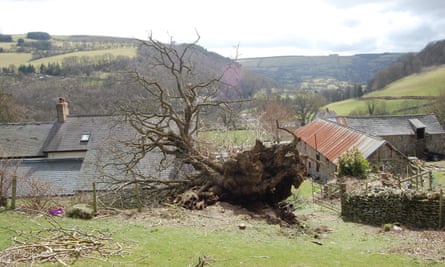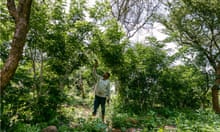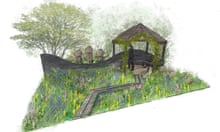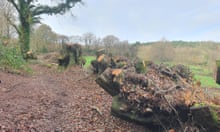On a stormy night in April 2013, a resounding crack echoed around a valley in north-east Wales and when day broke a melancholy sight met the eyes of villagers.
The mighty Pontfadog oak, a glorious tree that had stood sentinel over the Ceiriog valley for 1,200 years, had been toppled, and a heap of broken branches, decayed wood, lichens and fungi lying among the spring flowers.
Almost a decade later, a ceremony took place on Wednesday at the National Botanic Garden of Wales to mark the return of the oak in the form of five cloned saplings, two of which will be planted in north-east Wales, close to the spot where the magnificent tree stood.
“It’s emotional,” said Chris Williams, 69, a member of the family whose land at Cilcochwyn Farm the oak graced for dozens of generations. “When it fell it was like someone had died. We all grieved for it. It was more than just an oak tree sitting in a field, it was part of the family. What’s happening now is delightful – it feels like the circle of life continues. The Pontfadog oak is not dead. It lives and continues to be relevant.”

Williams fondly remembers playing on, around and in the hollowed-out oak as a child. “You could climb the outside and the inside. I remember shooing out cattle that had sheltered in there. A neighbour used it as an extra sheep pen, it was so big.”
His sister, Jo Williams, 71, added: For someone else it might be just a tree but it meant more than that for us. We played hide and seek in there, you could put in a table and six chairs and have dinner in it. So many people going back years had carved their initials in it.”
The tales spill out – a bull once went missing and was found in the oak. Two golden chisels, legend has it, were discovered in the tree.
When the tree came down she was shocked by the paucity of its roots. “They were hardly there.” It must have only been standing because of its weight. “That was sad to see.”
Alex Summers, curator of the National Botanic Garden of Wales in Carmarthenshire, explained that when the sessile oak (Quercus petraea) fell, a number of branches about the thickness of a pencil were taken. Experts at Windsor Great Park in Berkshire, home to one of the largest collections of ancient and veteran oak and beech trees in northern Europe, used their grafting skills to create five clones.
“They’ve grown them on and are now saplings of about 1.5 to 1.8 metres tall. They are genetically exactly the same as the Pontfadog oak. And now they are back here.”
Three will be planted on the approach to the great glasshouse at the botanic garden. Summers, who is overseeing the creation of a national arboretum there, said giants such as the Pontfadog oak were the survivors of forest that had once covered so much of Wales.
“Part of this project is protecting genetic diversity. We hope these saplings will live for 1,200 years themselves – they certainly have the pedigree to become ancient trees and it’s good to think that in 200 years or so people may be sitting in the shade of three nice big oak trees here.”
Two will be planted near Pontfadog, one at Chirk Castle, the other at Erddig, where a woodland to remember those who died during the Covid pandemic is being created as part of Welsh government plans to shape a new national forest.
Rob McBride, the self-styled “tree hunter”, who has just finished a 13-year audit of the many significant trees to be found on Offa’s Dyke, was effusive in his praise of the oak. “It was one of the most culturally significant trees ever to have grown on planet Earth.”
The Welsh first minister, Mark Drakeford, and the Prince of Wales were at the ceremony at the botanic gardens for this next part of the oak’s journey through time.
Drakeford told the story of a former Welsh prince, Owain Gwynedd, rallying his army beneath it before taking on, and defeating, the English at the battle of Crogen. “It meant a lot to Wales. I hope that the trees will grow and develop into mighty oaks that will stand for centuries to come.”










